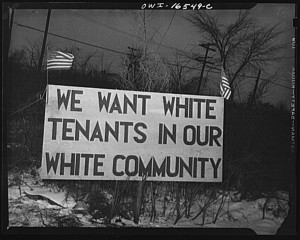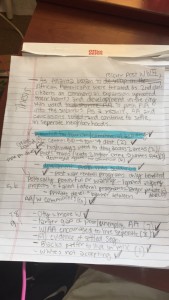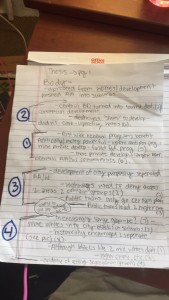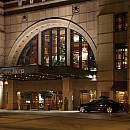Madison Brooks
Dr. Robin Wharton
Engl 1102
20 April 2016
Segregation is Not Over
As Atlanta, Georgia made steps to recover after World War II, African Americans were treated as second-class citizens by Caucasians as commercial expansion uprooted their homes and inner city development was used to push them out of the city and into the suburbs. As a result, African Americans and Caucasians began and continue to settle in separate communities.
African Americans and Caucasians live segregated mainly because Caucasians physically forced African Americans out of their existing homes and into the suburbs. After World War II, programs intended for reconstruction wound up only benefiting wealthy, politically powerful men(). These men were uninterested in improving areas of poverty in the city. Federal programs such as anti-poverty projects were gradually ignored, and as a result failed miserably. For example, Atlanta begun the Model Cities Program in 1966 in an effort to fix the problems in Atlanta’s low-income neighborhoods, which were mostly inhabited by African Americans (Holliman 21). The program was substantially underfunded and understaffed and did little for the living conditions of the select neighborhoods. Instead of finding other ways to improve these lower-class areas, politicians’ solutions were to simply destroy these “slums” and create new developments over them (Holliman 21). As well as African American families being forced out of their homes, this created larger activity in private development compared to federal government programs, which caused Caucasians to steadily drive an increasing gap between the social classes of Caucasians and African Americans (Pooley).
In the 20th century, in addition to ignored reconstruction programs, the Central Business District of Atlanta began to rapidly transform into a tourist destination, which also lead to increased private and commercial development (Holliman 3). Developers destroyed entire “slum” neighborhoods without a second thought in order to create this tourist destination that would bring thousands into the city (Pooley). This uprooted hundreds of African American families, which left them homeless and forced them out of the inner city and into the suburbs. This left mainly the Caucasians alone in the city communities. The expansion of the Civic Center in 1967 as well as the World Congress Center, Omi Complex, Hyatt Regency hotel, and much more brought in a large amount of tourism, but many of these developments were built directly on top of existing neighborhoods. This displaced more than 55,000 African American families (Newman 305). This development and relocation pushed African Americans into areas away from the main attractions, such as streets Auburn Avenue and Decatur Street. These streets became known as the “black” streets, which caused Caucasians to stay away, and left these streets undeveloped with a lower-income than the developed areas of Atlanta. In addition to these two streets, many areas in Atlanta played a major part of African American history and were therefore preserved by historical groups (Newman 315). Because of this preservation, many of these neighborhoods remained highly African American. Where most African Americans in the mid to late 1900’s settled is where they continue to mainly settle today.
Certain types of development, often referred to as Architectural Exclusion, purposely separated African Americans and Caucasians in Atlanta. Highways were built purposely as to create a barrier between African American and Caucasian communities. These highways were built on top of traditionally African American communities, which again forced them out of their homes and farther out into the suburbs. These highways also conveniently blocked access to the outlying neighborhoods, which were mainly lived in by African Americans (Sherman 14). Public Transportation routes also only travelled so far, and often denied certain groups access to certain places, such as African Americans being denied access to exclusive, mainly upper class Caucasian locations such as country clubs, high end restaurants, and gated communities (Sherman 31). The construction of the MARTA transportation routes destroyed homes of African Americans as well and forced them to find new homes elsewhere. The city was promised by city officials an extension of the MARTA lines to outlying areas which were heavily populated with African Americans after they were forced out of the city by developers, but the extensions were never built (Sherman 40). These types of architectural exclusion assisted in African Americans being exiled out into the suburbs farther away from the Caucasian communities.
African Americans have been historically discriminated against ever since post WWII in multiple ways. Specific groups were also formed in order to make them feel unwelcome in Atlanta. The Ku Klux Klan, or KKK, for example came together after the Civil War, and although it was disbanded multiple times, the group continued to fight for their idea of white supremacy. In the early 1900’s Atlanta became the headquarters for the KKK and held multiple rallies in places such as Stone Mountain. The group attacked and killed hundreds of African Americans by having their home, land, and possessions seized, lynched, shot, beaten, raped and even burned alive (Lay). During this time, African Americans feared for their lives. Even after the KKK was officially disbanded, African Americans were still threatened by members of the hate group. More than one thousand African Americans fled during these years and never returned (Lay). This contributed to a larger percentage of whites in Atlanta, as well as added to the tense differences of Caucasians and African Americans. When a select few decided to venture back, they still carried the fear and stigma of the KKK and made sure to stay far away from any Caucasians, which furthered the creation of segregated communities.
Years later during the twentieth century, as well as being physically forced out of their homes by developers, African Americans were pushed to feel unwelcome in places deemed to be dominantly Caucasian communities. This lead to citizens being settled in separate communities due to racism. Some property owners used “racial steering”, an illegal practice which pushed away African Americans and brought in Caucasians to their neighborhoods (Riley 3). This photograph is an example of racial steering, where a billboard being held up reads that a neighborhood only wants “white tenants in [their] white community” (Riley 3).
A study was conducted in Detroit by the University of Michigan in 1976 that concluded that 72% of “whites” said they strongly opposed living in a “mixed community” with “blacks” (Farley 321). When the researchers asked African Americans why they would not move into a mainly white neighborhood, 90% said that it was because their Caucasian neighbors would not welcome them (Farley 322). Since a large majority was in agreement in this study, it can be applied to the city of Atlanta by using the statistics to put into consideration that Caucasians and African Americans there most likely felt the same way.
In addition to having African Americans exiled, Caucasians often choose to live away from African Americans because of the increased gap between lower-class African Americans and middle class whites who reside in Atlanta (Pooley). The Atlanta Tribune Magazine reported that African Americans are 2x more likely to be jobless as well as 3x more likely to be poor (Bullard 2). Private development and architectural exclusion helped widen this economic gap. Because African Americans were pushed out of the city, it became difficult to find jobs in order for them to improve their economic circumstances. The magazine stated that 24% of African Americans do not own a car. This meant that without a way to travel to and from the city, these people must be able to walk to their place of employment (Bullard 2). This is a nearly impossible feat for those who live outside of the city where a majority of jobs are located in the downtown area. People settle traditionally near others culturally and economically similar to them. Because these two group’s gap is so large, it is presumed that they would not have naturally chosen to live in close proximity to each other.
In addition to this economic gap, Caucasians chose to settle away from African Americans because African Americans have been known to cause increased poverty, increased crime, as well as decreased home values (Poister 51). People who strongly believed these theories strongly opposed having their families live and grow up next to these criminal like people in fear that it might a negative impact on their day to day lives, like bad habits picked up by their children from the lower-class children, such as school being skipped.
Because of African Americans being excluded physically from the inner city on account of major development, preservation of historical areas, as well as fear, unacceptance, and prejudice from Caucasians, Caucasians continue to settle together in their own middle-upper class communities, while African Americans congregate together in neighborhoods farther out away from the main attractions of Atlanta. This segregation will unfortunately continue until Caucasians are able to accept the African American community and let them into their lives as being equal.
Works Cited
Bullard, Robert. “{Complete Report} The State of Black Atlanta 2010.” Atlanta Tribune The Magazine. Web. 29 Mar. 2016.
Farley, Reynolds. “Chocolate City, Vanilla Suburbs: Will the Trend toward Racially Separate Communities Continue?” Social Science Research 4 (1978): 319-44. Web.
Holliman, Irene V. “From ‘Crackertown’ to the ‘ATL’: Race, Urban Renewal, and the Re-making of Downtown Atlanta, 1945-2000.”University of Georgia (2010). n. pag. Web. 1 March 2016.
Lay, Shawn. “Ku Klux Klan in the 20th Century.” New Georgia Encyclopedia. 15 October 2015. Wrb. 25 April 2016.
Newman, Harvey K. “Race and the Tourist Bubble in Downtown Atlanta.” Urban Affairs Review3 (2002): 301-21. Web.
Poister, Theodore H. “Transit-Related Crime In Suburban Areas.” Journal of Urban Affairs 1 (1996): 63-75. Web.
Pooley, Karen. “Segregation’s New Geography: The Atlanta Metro Region, Race, and the Declining Prospects for Upward Mobility.” Southern Spaces. Web. 29 Mar. 2016.
Riley, Ricky. “10 Ways Segregation and Economic Depravity Defined Chicago – Atlanta Black Star.” Atlanta Black Star. 2015. Web. 29 Mar. 2016.
Sherman, Bradford P. “Racial Bias and Interstate Highway Planning: A Mixed Methods Approach.” College Undergraduate Research Electronic Journal (2014): n. pag. Web. 1 March 2016.





